
How to Use Battery Charging Module: Examples, Pinouts, and Specs
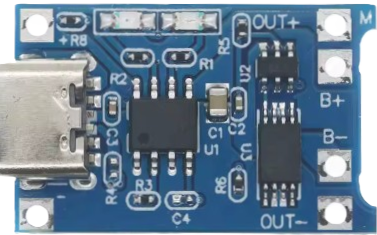
 Design with Battery Charging Module in Cirkit Designer
Design with Battery Charging Module in Cirkit DesignerIntroduction
The TP4056 Module (Type C), manufactured by Shenzhen Technology Co., is a compact and efficient battery charging module designed for charging lithium-ion batteries. It ensures safe and reliable charging by incorporating features such as overcharge protection, short-circuit protection, and automatic charge termination. This module is particularly suited for single-cell lithium-ion or lithium-polymer batteries.
Explore Projects Built with Battery Charging Module
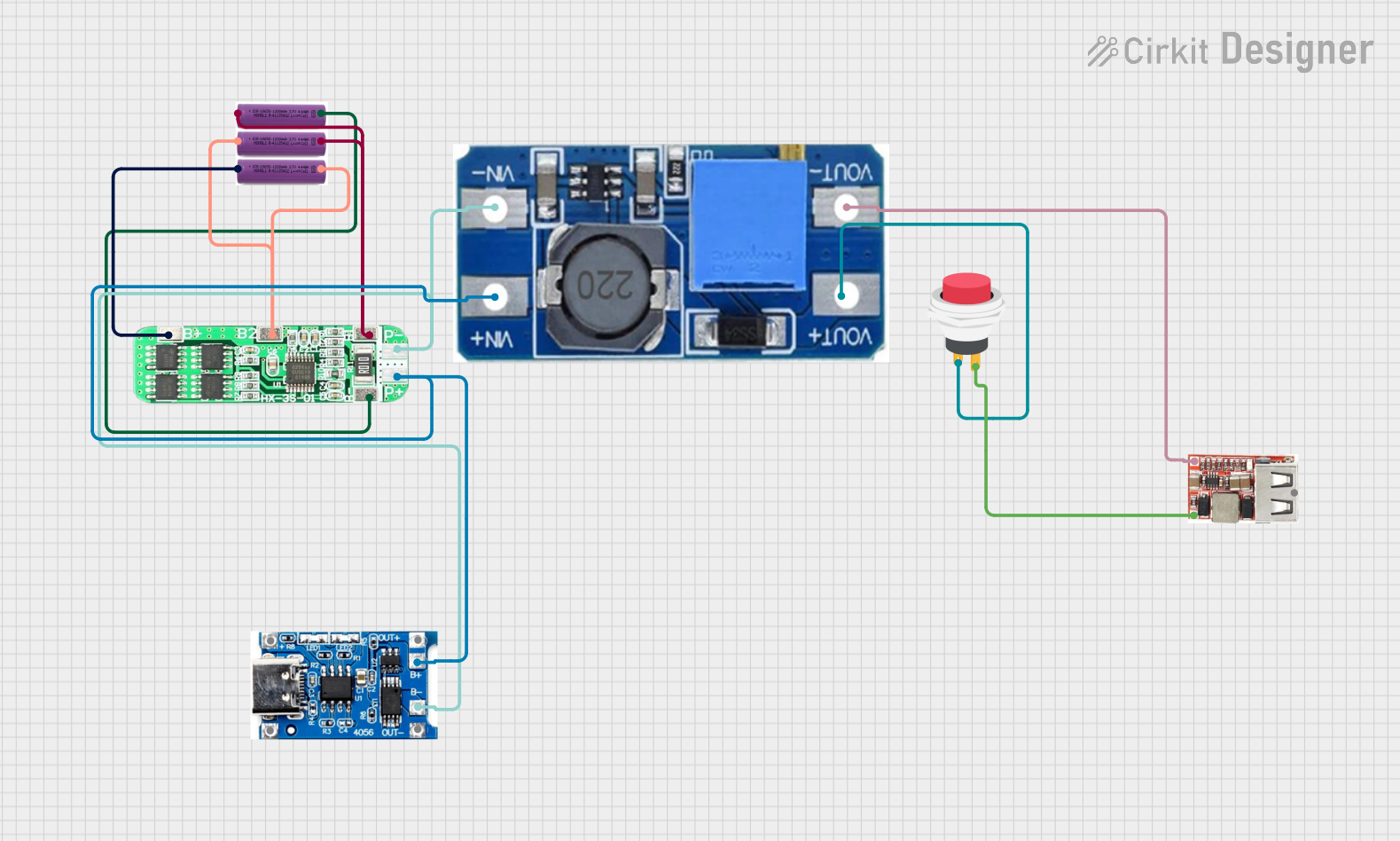
 Open Project in Cirkit Designer
Open Project in Cirkit Designer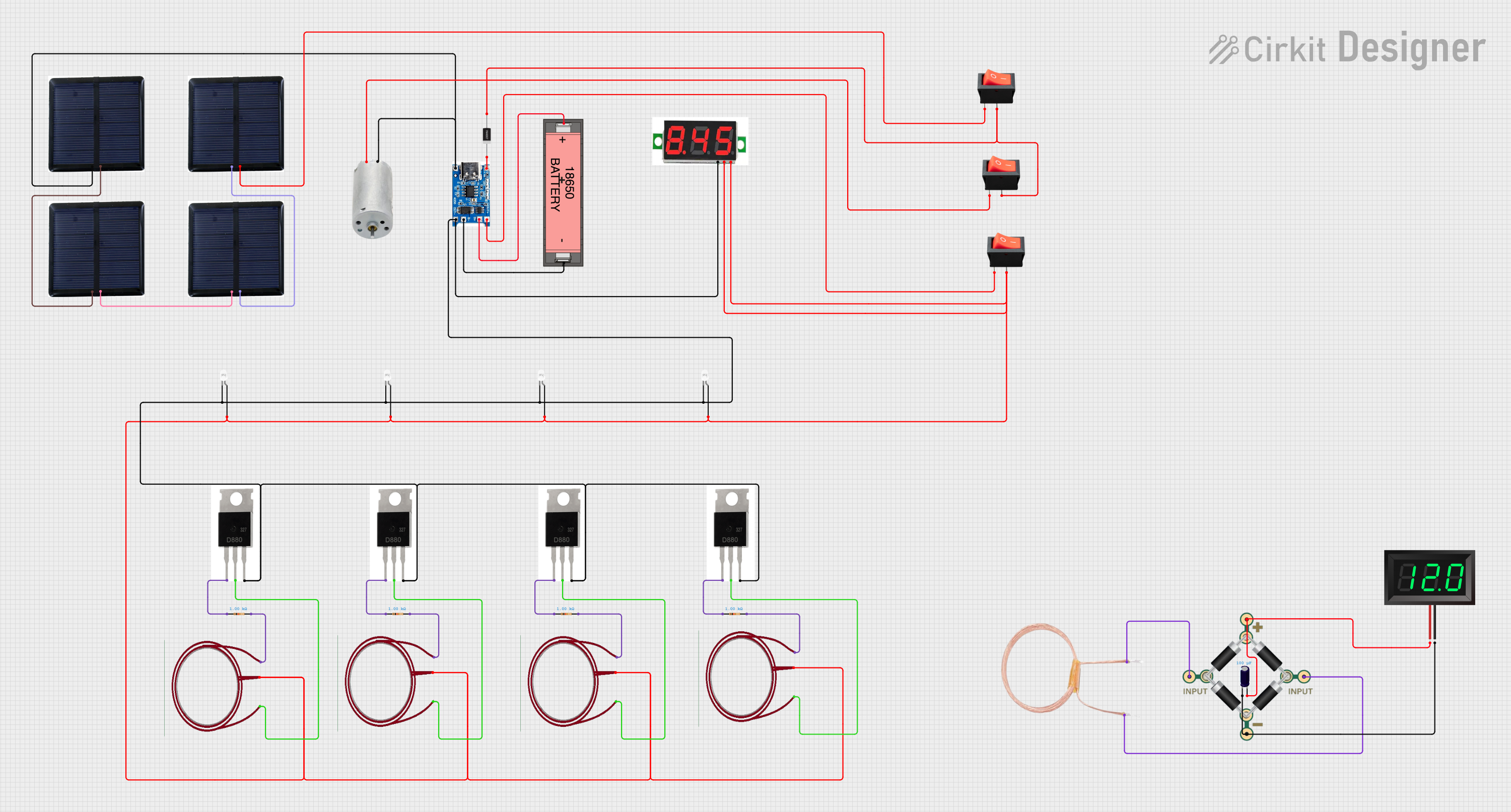
 Open Project in Cirkit Designer
Open Project in Cirkit Designer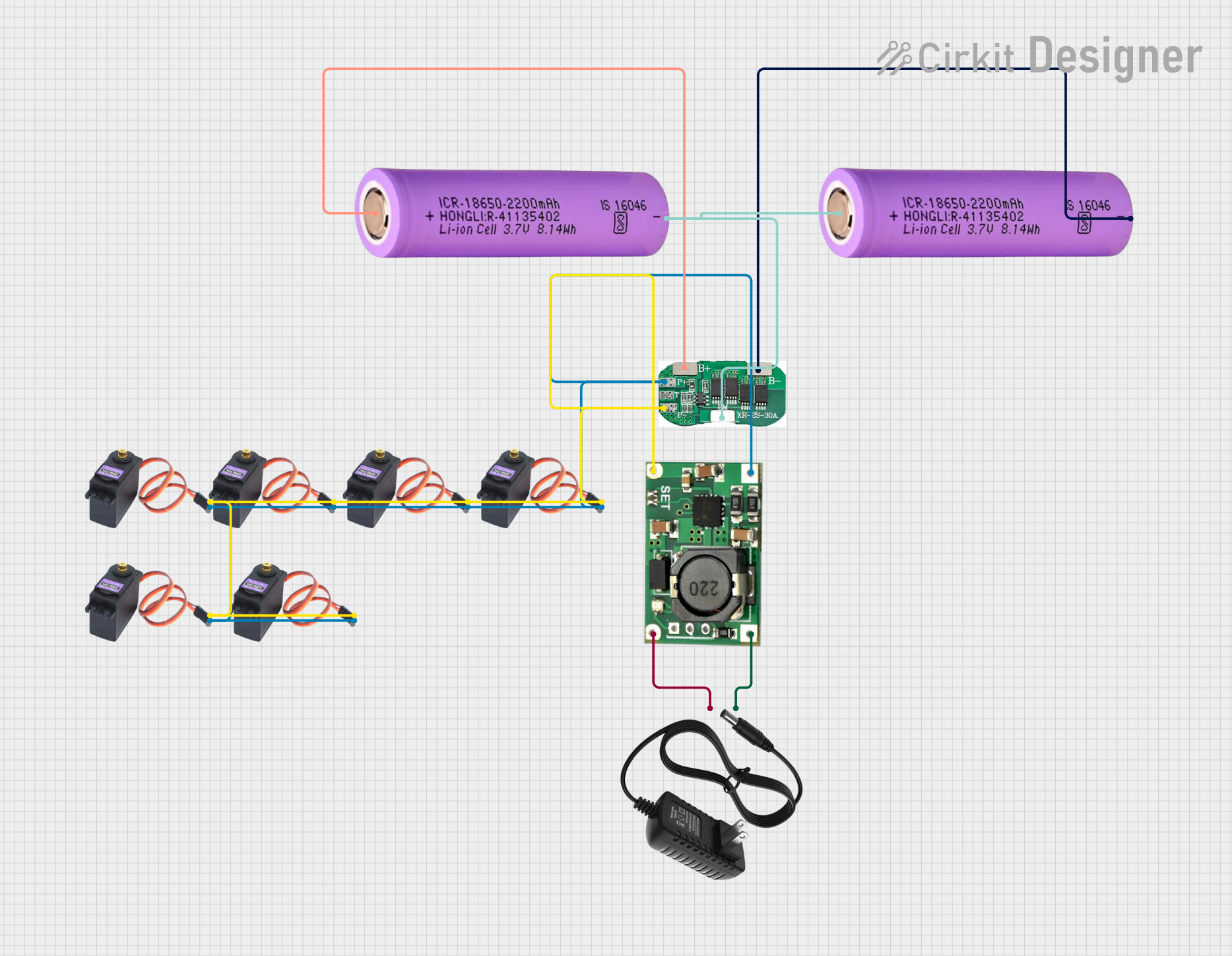
 Open Project in Cirkit Designer
Open Project in Cirkit Designer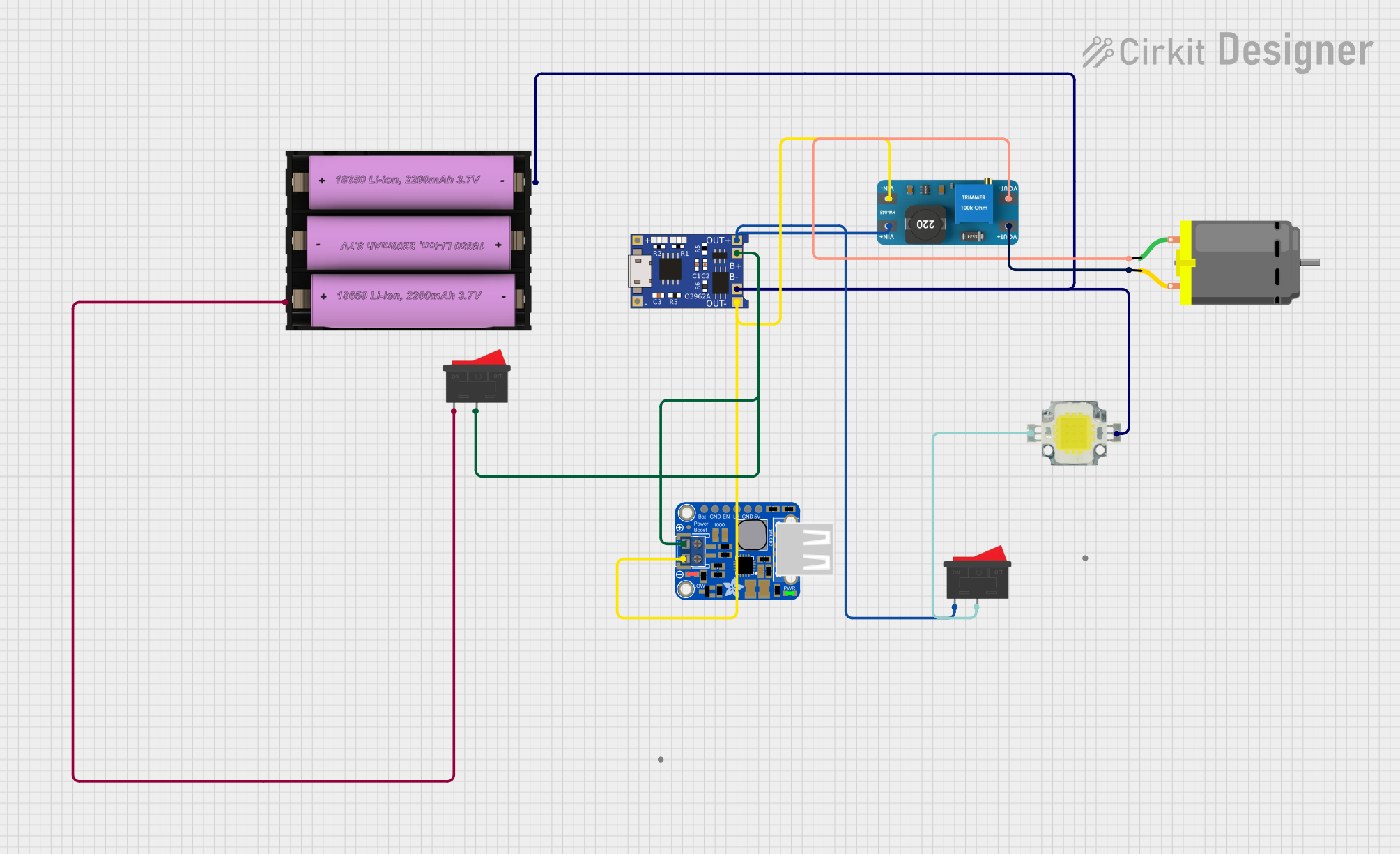
 Open Project in Cirkit Designer
Open Project in Cirkit DesignerExplore Projects Built with Battery Charging Module

 Open Project in Cirkit Designer
Open Project in Cirkit Designer
 Open Project in Cirkit Designer
Open Project in Cirkit Designer
 Open Project in Cirkit Designer
Open Project in Cirkit Designer
 Open Project in Cirkit Designer
Open Project in Cirkit DesignerCommon Applications and Use Cases
- Charging rechargeable lithium-ion batteries in portable devices
- Power banks and battery-powered projects
- DIY electronics and prototyping
- Wearable devices and IoT applications
- Solar-powered battery charging systems
Technical Specifications
Below are the key technical details of the TP4056 Module (Type C):
| Parameter | Value |
|---|---|
| Input Voltage Range | 4.5V to 5.5V |
| Charging Current | Adjustable, up to 1A (default: 1A) |
| Battery Type Supported | Single-cell Li-ion/Li-Po (3.7V) |
| Charging Voltage | 4.2V ± 1% |
| Input Connector | Type-C USB |
| Protection Features | Overcharge, Over-discharge, |
| Short-circuit, Reverse Polarity | |
| Operating Temperature | -10°C to +85°C |
| Dimensions | 25mm x 19mm x 5mm |
Pin Configuration and Descriptions
The TP4056 Module (Type C) has the following pinout:
| Pin Name | Description |
|---|---|
| IN+ | Positive input voltage (4.5V to 5.5V). Connect to the positive terminal of the |
| power source (e.g., USB Type-C). | |
| IN- | Negative input voltage. Connect to the ground of the power source. |
| BAT+ | Positive terminal for the battery connection. |
| BAT- | Negative terminal for the battery connection. |
| OUT+ | Positive output terminal for the load (optional). |
| OUT- | Negative output terminal for the load (optional). |
Usage Instructions
How to Use the TP4056 Module in a Circuit
Connect the Power Source:
- Use a Type-C USB cable to connect the module to a 5V power source (e.g., USB adapter, power bank, or computer).
- Alternatively, connect a 4.5V to 5.5V DC power supply to the
IN+andIN-pins.
Connect the Battery:
- Attach the positive terminal of the battery to the
BAT+pin and the negative terminal to theBAT-pin. - Ensure the battery is a single-cell lithium-ion or lithium-polymer type with a nominal voltage of 3.7V.
- Attach the positive terminal of the battery to the
Optional Load Connection:
- If you want to power a load while charging the battery, connect the load to the
OUT+andOUT-pins. - Note: The load current should not exceed the module's maximum output current.
- If you want to power a load while charging the battery, connect the load to the
Monitor the Charging Status:
- The module has two onboard LEDs:
- Red LED: Charging in progress.
- Blue LED: Charging complete.
- The module has two onboard LEDs:
Important Considerations and Best Practices
Adjusting the Charging Current:
The default charging current is 1A. To adjust it, replace the onboard resistor (Rprog) with a different value. Refer to the TP4056 datasheet for resistor values corresponding to specific charging currents.Battery Protection:
Ensure the battery has built-in protection circuitry, or use an additional protection module to prevent over-discharge and overcurrent.Heat Dissipation:
The module may heat up during operation, especially at higher charging currents. Ensure adequate ventilation or heat sinking if necessary.Avoid Reverse Polarity:
Double-check the polarity of the battery and power connections to avoid damaging the module.
Example: Using the TP4056 Module with an Arduino UNO
The TP4056 module can be used to charge a battery that powers an Arduino UNO. Below is an example of how to monitor the battery voltage using the Arduino:
// Example code to monitor battery voltage using Arduino UNO
const int batteryPin = A0; // Analog pin connected to BAT+ via a voltage divider
const float voltageDividerRatio = 2.0; // Adjust based on your resistor values
const float referenceVoltage = 5.0; // Arduino's reference voltage (5V for UNO)
void setup() {
Serial.begin(9600); // Initialize serial communication
pinMode(batteryPin, INPUT); // Set the battery pin as input
}
void loop() {
int rawValue = analogRead(batteryPin); // Read the analog value
float batteryVoltage = (rawValue / 1023.0) * referenceVoltage * voltageDividerRatio;
// Print the battery voltage to the Serial Monitor
Serial.print("Battery Voltage: ");
Serial.print(batteryVoltage);
Serial.println(" V");
delay(1000); // Wait for 1 second before the next reading
}
Note: Use a voltage divider circuit to scale down the battery voltage to a safe range for the Arduino's analog input (0-5V). Choose resistor values accordingly.
Troubleshooting and FAQs
Common Issues and Solutions
Module Overheating:
- Cause: High charging current or insufficient ventilation.
- Solution: Reduce the charging current by replacing the Rprog resistor or improve heat dissipation.
Battery Not Charging:
- Cause: Incorrect wiring or damaged battery.
- Solution: Verify the connections and ensure the battery is functional.
LEDs Not Lighting Up:
- Cause: No power input or faulty module.
- Solution: Check the power source and ensure the input voltage is within the specified range.
Load Not Powering On:
- Cause: Load current exceeds module's output capacity.
- Solution: Reduce the load current or use a higher-capacity charging module.
FAQs
Can I use the TP4056 module to charge multiple batteries in series?
No, the TP4056 is designed for single-cell batteries only. Charging multiple cells in series requires a specialized balance charger.What happens if I leave the battery connected after it is fully charged?
The module automatically stops charging when the battery is full, preventing overcharging.Can I use the module with a solar panel?
Yes, as long as the solar panel's output voltage is within the 4.5V to 5.5V range and provides sufficient current.Is it safe to use the module without a protection circuit?
While the TP4056 has built-in protection features, it is recommended to use batteries with integrated protection circuits for added safety.
This concludes the documentation for the TP4056 Module (Type C).